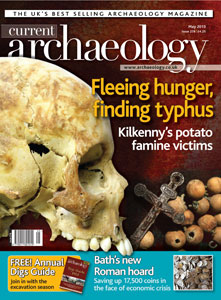The Irish Potato Famine, or Great Hunger, took a terrible toll. Between the million who died and the million more who emigrated to escape, it cost Ireland a quarter of its population. Now, excavations at the former Kilkenny Workhouse have unexpectedly unearthed a cluster of long-forgotten mass graves holding famine victims. Providing a rare opportunity to balance historical accounts against the physical remains of a community devastated by the famine, it reveals how a tragic misdiagnosis compounded the suffering.
Tumbled walls are a staple of a countryside ramble, but just how old are they? Recent research has suggested that many of the Lake District’s fallen walls were built far earlier than anyone suspected. They are providing a new insight into how the uplands were tamed.
A scatter of loose Roman coins at a redevelopment site in Bath led to the discovery of a massive Roman hoard. Containing 17,500 coins, x-raying the cache proved it comprised of multiple money bags laid down over a period of 30 or more years. We investigate what this means for our understanding of Roman hoarding.
Peering into a services trench in Aylesbury provided the first glimpse of a previously unknown hillfort. Later excavations revealed a remarkable group of Iron Age burials including both humans and animals.
Free inside this issue, for those of you who live in the UK, is our annual Digs Guide. The indispensable guide to this summer’s excavations, it is crammed with opportunities to get involved with teasing out the past. For those of you enjoying the magazine further afield an electronic version of the guide can be downloaded from here.
Finally, a very big thank you to everyone who came to the 2013 Current Archaeology conference. You can find out what we have been up to in the magazine, and read a few words from our award winners. Congratulations to them all!
/n
FEATURES/n
/n
THE KILKENNY WORKHOUSE BURIALS/n
An archaeology of the Irish Potato Famine
Excavations at a previously-unknown workhouse cemetery have uncovered 63 mass graves ‚ the most ever found in Ireland – and shed new light on the human cost of Ireland’s Great Hunger.
TAMING THE LAKE DISTRICT/n
Cairns, fields, and cultivation
Often overlooked or mistaken for modern features, the Lake District’s wealth of prehistoric field boundaries reveal the history of Cumbrian agriculture.
THE BEAU STREET HOARD, BATH/n
An unusual Roman cache from an unusual Roman town
What does the discovery of over 17,500 3rd century coins, stored in a series of leather bags, add to our understanding of how Roman hoards accumulated?
DISCOVERING AYLESBURY’S HILLFORT/n
Defensive ditches and ritual Iron Age burials
Excavations within a previously-unknown hillfort have revealed the remains of a woman and four children, laid to rest in the 4th century BC surrounded by a mass of animal bones.
NEWS/n
Chester’s lost ditch research; Cambridge’s Roman development; Saxons in Somerset?; Grave discoveries in London; Hartlepool: on the button; Welsh winter wonderland; Kendall’s man of mystery; Practical archaeology.
REGULARS/n
Conference
A round-up of what went on at Current Archaeology Live! 2013
Reviews
Northumbria: the lost kingdom; The story of Roman Bath; A history of death and burial in Northamptonshire
Sherds
Chris Catling’s irreverent take on heritage issues.
Mick’s Dig Diary
Mick Aston maps out the importance of local cartography to community archaeology projects
Odd Socs
The Guild of One-Name Studies

